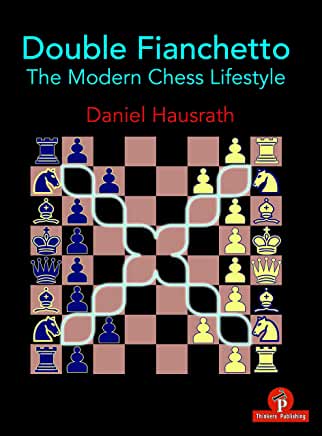Double-Fianchetto – 1st Edition
The Modern Chess Lifestyle
Daniel Hausrath

Today chess theory is exploding and entire books are written on single variations. The idea of solving all of one’s opening problems for both White and Black with just one volume seems to be too good to be true, but German Grandmaster Daniel Hausrath begs to differ.
His first book Double-Fianchetto: The Modern Chess Lifestyle (Thinkers Publishing, 2020, 271 pages, paperback, figurine algebraic, list price $35) offers ideas on how to build a repertoire after the moves b2-b3, g2-g3, …b7-b6 and …g7-g6.
Unlike most Thinkers Publishing efforts, which are arranged like standard opening book, Hausrath’s work is arranged around 62 model games. This works well for the subject matter under discussion which is based more around ideas and strategies than long concrete variations.
As White the repertoire typically begins with 1.Nf3 and 2.g3, meeting the King’s Indian/Grunfeld with 3.b3, a variation Vladimir Kramnik started to play near the end of his career. The double fianchetto also works well against the Dutch, certain lines of the Queen’s Gambit (the Tarrasch for example) and various variations in the Reti. It’s also possible to transpose into some line Hausrath covers via 1.g3 or 1.c4.
One sharp game the author examines starts slowly but quickly heats up. Witness Shtembuliak-Bivol, Saint Louis 2018, which began:
1.Nf3 Nf6 2.g3 g6 3.b3 Bg7 4.Bb2 b6 5.Bg2 Bb7 6.0-0 c5 7.c4 0-0 8.Nc3 Nc6?! 9.d4 Nxd4 10.Nxd4 Bxg2 11.Kxg2 cxd4 12.Qxd4 d5!
Hausrath explains that Black has to play this or end up in a very passive position.
13.cxd5
The correct practical try. White could play solid with 13.Rfd1 dxc4 14.Qxc4 Qc8 15.Qxc8 Raxc8 16.Rac1 but his advantage would be tiny at best.
13…e6! 14.Rad1 Nxd5 15.Qxg7+!!
(Hausrath) This move does not win but sets Black difficult problems.
15…Kxg7 16.Nxd5+ Kh6 17.Nf6 Qc8??
17…Qc7! (to cover the f4 square holds).
18.Ng4+ Kh5 19.Nf6+??
Here White missed a pretty win with 19.Bf6! Kxg4 (19…Qc6+ 20.f3) 20.Rd4+ Kf5 21.Rf4# (not possible with the Black queen on c7 as 21…Qxf4 would be possible.
19…Kh6 20.Ng4+ Kh5 21.Nf6+, ½–½.
As one might expect the Modern Defense features prominently in the Black repertoire on offer but Hausrath also offers other possibilities: for example 1.e4 c5 2.Nf3 g6 3.d4 cxd4 4.Nxd4 g6 5.Nc3 Bg7 6.Be3 Nf6 7.Bc4 0-0 8.Bb3 b6 – the Sicilian Accelerated Dragon interpreted as a double fianchetto. Against 1.d4 the Queen’s Fianchetto gets the thumbs up – 1.d4 Nf6 2.c4 b6 3.Nf3 Bb7 4.Nc3 g6 or 1.d4 Nf6 2.c4 b6 3.Nc3 Bb7 4.Qc2 d5 5.cxd5 Nxd5 6.e4 Nxc3 7.bxc3 e5 8.dxe5 Nd7 9.Nf3 Qe7 10.Bf4 0-0-0 11.Bc4 h6 12.0-0 g5 13.Bg3 Bg7.
The heart of this book are Hausrath’s insightful annotations, primarily prose, which cover all parts of the game (opening, middlegame and endgame).
If you are interested in double fianchetto setups with either color, or if you only want to improve your positional understanding, Double-Fianchetto: The Modern Chess Lifestyle is in the book for you.
